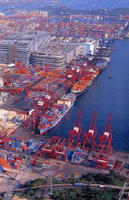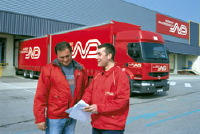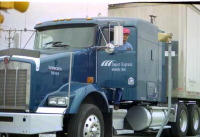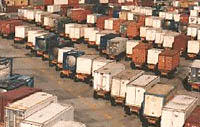Nov 18, 2002Nov. 18, 2002 - Some senior supply chain executives refer to logistics as "the Black Hole." They closely monitor what's being produced in their factories and what's stored in their warehouses and distribution centers, but when goods leave those physical locations, visibility is completely lost. This contributes to supply chain theft, causes revenue losses due to out of stocks and swells inventory unnecessarily because no one knows if a delivery is going to arrive on time.
RFID has the potential to dramatically improve in-transit visibility, when it is coupled with other wireless technologies, including cellular and global positioning system (GPS) tracking. These technologies can not only tell you where your goods are at any moment in time, they can improve vehicle utilization, ensure the timely delivery of goods, and slash supply chain losses.
In most of the sections of this special report, we focus primarily on passive RFID technology – that is, low-cost tags and labels that don't use batteries to broadcast a signal. But logistics has some special requirements that can't be handled with passive tags alone. In this section of the report, we'll spell out how you can get complete item-level visibility of goods in-transit using passive and active tags with cellular and GPS technologies. And then we'll explain how sensors can be added to the system and how software will eventually respond automatically to disruptions.
The basic technologies needed to track goods in transit have been around for a while. GPS is used to plot the precise location and speed of the truck, and then cellular technology is used to relay the information to a central monitoring station. The data can be made available over the Web or plugged into enterprise applications (after doing the software integration).
Such systems used to be too expensive to outfit an entire fleet. When Qualcomm first introduced its OmniTRACS system, it cost upwards of $5,000 to outfit a single truck. Today, a low-end system can cost less than $500, plus $10 to $60 per month, depending on how often you want the vehicle to report its position. (Pricing is often based on the number of transmissions.)
These systems are not uncommon, but very few companies have combined them with RFID to get item- or case-level visibility in transit. Marrying the two systems can provide enormous benefits.
Bruce Jacquemard, executive vice president of global field operations, for Savi Technology, refers to the Russian doll approach to logistics tracking. Russian dolls are stored one inside another inside another. To get item-level visibility, you store one item inside another and put that inside another. Software matches the container and its content, so all you have to do is track the largest container.
Here's how it works. Let's say you are a large retailer. Orders from stores come in to the distribution center. Employees pick the cases ordered. As they load the cases on a pallet, passive RFID tags on the cases communicate unique ID numbers to a reader. The pallet is tagged with a passive 915 MHz RFID tag or an active tag. The system matches the ID number on the pallet to all the IDs on the cases.
As the pallet is loaded into the back of a tractor-trailer, along with a dozen others, an RFID reader picks up all the pallet IDs. When the trailer is closed, an active (battery-powered) RFID tag on the trailer is scanned. The pallet IDs are matched to the trailer ID, and the information is uploaded to a database. (To prevent theft, the truck can be sealed with an electronic seal that will report when the trailer is opened without authorization.) Now, someone with authorized access to a Web site can find out exactly which cases are in the vehicle, or enter a pallet or case ID number and find out which vehicle it is on.
As the driver travels to a store, the GPS tracks his position in real time. Software systems can be set up so that if he goes off an appointed route, an alert is sounded (this is called "geo-fencing"). When he arrives at a store, he enters a store number on a handheld or dashboard mounted computer, which sends the information via cellular network to the monitoring center. The store number is matched to the location of the truck. So if Bob says he's at store 123, the system knows the GPS coordinates of store 123 and confirms that he is where he says he is.
If there is an e-seal on the truck, the system can now authorize the driver to open the door. He then reads the tags on the pallets as they are removed from the container. The DC thus confirms that it has delivered exactly what was ordered by the store. The system can sound a alert if the wrong containers are removed. This same set up can be used by manufacturers to create an audit trail that can be used to settle delivery disputes with retailers.
The same system can work with smaller deliveries in which individual items are picked and placed in plastic containers, so they can be delivered to a number of stores. The bar codes on the items can be scanned and associated with an RFID tag on the plastic container. Then the containers can be tracked as the driver delivers them. In each case, as the driver pulls the plastic boxes from the truck and scans them, the system confirms whether he has the right ones, which reduces errors.
Outfitting a tractor-trailer with a complete system, including electronic seals, costs about $1,000, plus another $1,000 per year for operating expenses and maintenance of the system. That's not beyond the means of most fleet owners. But for any system to work, you have to figure in the cost of the software that's going to turn the data from the trucks into useful information.
There are a number of systems on the market, such as Savi's SmartChain platform, which can aggregate information from most data collection devices. Other companies, including Ameritrac Wireless of Atlanta, have developed tracking applications that can provide information through a Web portal.
The total cost of the system might be $500,000 to $1 million, depending on the complexity of the integration with legacy systems. Let's take a retailer with $1 billion in sales per year. It has 120 tractors and 400 trailers of different size. Taking the high end of our estimate, let's say the company spends $1 million on software and integration and $1,000 to outfit each tractor and trailer with the tracking equipment. That's $1.52 million to implement the system.
How long will it take for the company to recoup that investment? Studies show that 46 percent of shrinkage in the United States is due to employee theft. Another 18 percent is due to administrative error and 6 percent is due to vendor fraud. Perfect supply chain visibility should have a dramatic impact on each of these areas. But let's be conservative and say it reduces loss by 50 percent in each area.
A typical retailer in the United States loses 1.8 percent of sales per year to shrinkage (the figure is slightly higher in Europe and other regions). So our theoretical retailer is losing $18 million per year. The tracking system could reduce those losses by 35 percent (half of the 70 percent attributed to employee theft, administrative error and vendor fraud), meaning the system would save about $6.3 million per year. That's a compelling return on investment.
Each company with a fleet will need to look at its own operations and design a system that makes the most sense for its needs. A retailer might focus on cutting supply chain loss, avoiding misdirected shipments and reducing out of stocks. A supplier or distributor might focus on making sure that it delivers exactly what was ordered within a precise time window for just-in-time manufacturing. And a third party logistics provider might focus on gathering the data that its customers need to run their operations efficiently.
Regardless of what type of operation you run, RFID offers powerful advantages when coupled with GPS and cellular tracking and communications technologies. But the benefits we've described so far are only the beginning. Once the core infrastructure is in place, companies can build on it to gain additional advantages.
The ability to build on a system that is already delivering an ROI is one of the most attractive aspects of RFID technology. For instance, if trailers and tractors already have active tags that communicate with readers at the entrances and exists of depots, a retailer can install a real-time location system in the truck yard to automate the flow of traffic through the yard, dramatically boosting efficiency and cutting costs.
Associated Foods Stores of Salt Lake City installed a yard management system from WhereNet and OMI International at its 600-acre distribution center in Farr West, Utah. The system automatically tracks the location and status of 400 trucks as they move through various stations in the yard. The system cost less than $1 million for hardware, software and integration. (This was a standalone project.)
After the system went live, the company was able to eliminate two full time administrative positions at the depot, and it slashed the number of tractors in the fleet to 67, from 120 a year ago. Each tractor costs $80,000, and the company saves $40,000 to $50,000 a year on the driver's salary. Associated Food Stores also reduced the number of tractors, and it saves money on produce that went bad while trucks sat in the yard waiting for space at a dock door. The system paid for itself within the first year.
Companies can safeguard food and ensure freshness by adding temperature sensors to the basic tracking system. KSW-Microtec of Germany has developed a temperature sensor that costs just $3 when purchased in bulk (see New Low-cost Temperature Sensors). Temperature sensors could warn a central monitoring station when a truck door has been left open and ensure that meat isn't left on a dock for an hour in the hot sun.
Once companies are able to gather detailed information about the location of goods in transit, they will be able to determine where goods are being lost or stolen. (The ECR Europe Shrinkage report found that fast-moving consumer goods companies can't account for $10 billion in supply chain losses per year.) And they will be able to identify points of inefficiency. Scottish Courage Brewery reduced its cycle time from 47 days to 40 days by tracking its beer kegs with RFID tag. For each day the company cut off the cycle, it could reduce its keg inventory by $1 million.
The ultimate goal of supply chain visibility is efficiency – delivery the right goods to the right place at the right time. There will always be disruptions, and humans won't be able to react to all the data from tracking systems. So eventually, companies will turn to intelligent software agents. Agents are a relatively new branch of software development. Essentially, they are software programs that use a set of rules, weightings and complex algorithms to figure out how best to respond to different conditions.
Agents can interact and negotiate with each other, which enables them to react to changing conditions dynamically. SAP has been working with a company called BiosGroup on an automated replenishment system. (see Agents Key to RFID Supply Chains) But the same technology can be applied to logistics.
If, for instance, a satellite tracking system reports that a truck has stopped moving, the control center can message the driver. If the driver says his axle has broken, the system knows everything on the truck and where it's going. It also knows which items must be delivered at a specific time to avoid an out of stock situation, or a problem on a just-in-time assembly line. The dispatch agent at a local depot might reprioritized shipments, based on rules set by managers, and message another driver to change his route and deliver the needed goods.
Such sophisticated software system, while available today, probably won't become common for five to 10 years. But it's clear that RFID will play an important role in securing cargo, guaranteeing the freshness of food, reducing theft and saving companies millions of dollars per year. Savvy companies aren't waiting until there are tags in every bar of soap to begin installing these systems. They are moving ahead based on the benefits available today.




